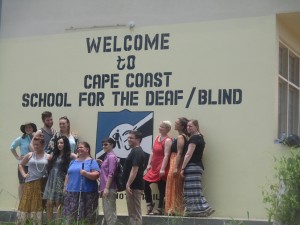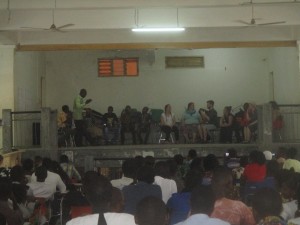The past week has been such a gift! The Western Oregon University service learning group of 9 students and 2 faculty arrived in Winneba on Sunday. I met them at Manuel’s Guesthouse. (See them texting? No wi-fi in Cape Coast!)
Seeing my Oregon friends in Ghana seemed so natural and fitting.
My husband and I hosted them Sunday night. Some of them were having coffee withdrawal. Nescafe instant coffee is just not the same! They brought us about a dozen packages of our favorite Double French Roast Coffee! We had enough to share!
The UEW interpreters and interpreter interns also joined us on Sunday night. We sat in a huge circle in the living room and they shared experiences in turn.
On Monday, Carolina and I walked the two student leaders and the two faculty over to the inclusive school to introduce them to the Headmistress. Frank and I joined them at Manuel’s in the evening. On Tuesday, the UEW 400-level students hosted them on the beach. We sat in a huge circle and introduced ourselves in Sign Language.
After that, the UEW students shared Sobolo, a delicious drink made with Hibiscus leaves, sugar, ginger, and boiled water. Sahadatu, one of the UEW students, made the drinks! Oh, so delicious! Then they gave us coconut. We visited and took lots of photos. It was a great afternoon. Thank you, UEW EHI Students!
 On Wednesday morning, the group came to my 100-level sign language class. The 300-level students also joined us. We had well over 100 students in the South Assembly Hall! We set up a panel discussion between some of the WOU students and some of the UEW students who are Deaf.
On Wednesday morning, the group came to my 100-level sign language class. The 300-level students also joined us. We had well over 100 students in the South Assembly Hall! We set up a panel discussion between some of the WOU students and some of the UEW students who are Deaf.
The 100-level students were frustrated, because we did not have the discussion interpreted. The experience was educational in that they got to observe communication with a Deaf Blind student. They observed introductions and interpretation. After the panel, they sat in small groups with each of the WOU students and shared experiences.
 I had hoped to have them play games, but once we stood up, the pens and papers, and cameras came out. The photo-taking began.
I had hoped to have them play games, but once we stood up, the pens and papers, and cameras came out. The photo-taking began.
The students departed for Cape Coast after lunch. Thanks to the Head of Department in Special Education at UEW, a vehicle was provided for this trip. I rode with them, but there was not enough room for Frank to also join. I treated them to Fanmilk, frozen yogurt. You should have seen the delight in their faces when they bet off the corner of the package and sucked in the ice-cold yogurt!
We dropped them at Heaven’s Lodge and headed back to Winneba.
On Thursday, Frank and I headed back to Cape Coast to visit the Cape Coast School for the Deaf and Blind.
We wanted to see the cultural troupe of deaf children and blind children dancing and drumming. Amazing!
We stayed at Heaven’s Lodge with the WOU group, joining them for lunch, dinner, and breakfast.
On Friday, we went back to the school. Though it was Good Friday and there were no classes in session, we were able to visit with the children. Patrick Graham, coordinator of the Deaf Education program at WOU, lead us all in a couple of games, Bear Hug ( a number game I will try with the UEW students) and Elephant (a game that promotes attention, observation, and hand-eye coordination skills). Then he told some jokes and JennyLynn did an ABC story about her experience in Ghana and a number, 1-5, story. Sheridan also told a story.
 Frank and I hoped to ride with the group to Winneba Junction, but the van was loaded with luggage and had just enough room for the 11 students and the driver. So, Frank and I caught a tro tro. As usual, that was an adventure! When we arrived at the Apom Junction, the police blocked the tro tro, took the tro tro driver’s license and did not return it until the Mate paid the driver of the police vehicle.
Frank and I hoped to ride with the group to Winneba Junction, but the van was loaded with luggage and had just enough room for the 11 students and the driver. So, Frank and I caught a tro tro. As usual, that was an adventure! When we arrived at the Apom Junction, the police blocked the tro tro, took the tro tro driver’s license and did not return it until the Mate paid the driver of the police vehicle.
We stayed in touch with the group via texting on mobile phones and Facebook chatting until they departed Saturday night.
I am so grateful for that group! They represented WOU’s Deaf Studies and Professional Studies beautifully! Thank you!















 This is about 75 students working in groups.
This is about 75 students working in groups.